15 Famous Stories of Execution
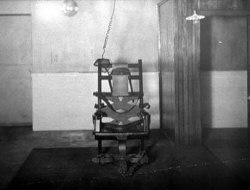 Throughout the history of mankind, millions of people have been executed for
one reason or another. In most cases, these individuals were sentenced to death
because of violating a major law. The rules and regulations stipulating
executions have drastically changed in recent centuries, especially when it
comes to such forms of execution that can be considered as being cruel and
unusual punishment in many countries today. However, there have still been many
different executions that have made their way into the history books. Although
the majority of history's more notable executions ended just as you'd expect,
there have also been quite a few that have led to surprise endings and
unexpected twists. Throughout the history of mankind, millions of people have been executed for
one reason or another. In most cases, these individuals were sentenced to death
because of violating a major law. The rules and regulations stipulating
executions have drastically changed in recent centuries, especially when it
comes to such forms of execution that can be considered as being cruel and
unusual punishment in many countries today. However, there have still been many
different executions that have made their way into the history books. Although
the majority of history's more notable executions ended just as you'd expect,
there have also been quite a few that have led to surprise endings and
unexpected twists.
Here are 15 famous stories of execution:
15) Mary Surratt
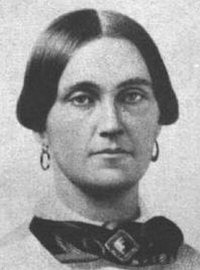 The first execution of a woman in the history of the United
States took place when Mary Surratt was put to death for her role in a
presidential assassination. Even though John Wilkes Booth was the man who was
primarily responsible for the actual murder of President Abraham Lincoln, Mary
played a key role along with the other conspirators in order to make that
assassination attempt a tragic success. Mary owned her own tavern in a town in
Maryland that used to be called Surrattsville but is now known as Clinton. She
was forced to convert her home from a row house into a boardinghouse after her
family stumbled across an extensive series of financial problems and
difficulties in Washington, D.C. The first execution of a woman in the history of the United
States took place when Mary Surratt was put to death for her role in a
presidential assassination. Even though John Wilkes Booth was the man who was
primarily responsible for the actual murder of President Abraham Lincoln, Mary
played a key role along with the other conspirators in order to make that
assassination attempt a tragic success. Mary owned her own tavern in a town in
Maryland that used to be called Surrattsville but is now known as Clinton. She
was forced to convert her home from a row house into a boardinghouse after her
family stumbled across an extensive series of financial problems and
difficulties in Washington, D.C.
It was in that boardinghouse that Mary allowed the numerous conspirators, one
of which was the actual assassin, to meet and discuss their assassination plans
over an extended period of time. Even though Mary did not have anything to do
with the assassination directly and primarily only allowed the people involved
to use her home as a meeting place, her association with the conspirators as
well as her close friendship with John Wilkes Booth were the two key factors
that led to her death.
Mary Surratt's Boarding House - Meeting Place For Lincoln
Conspirators:

Centuries later, many people are still arguing and
debating over whether her execution was warranted or if an extended prison
sentence would have been more suitable for the actual crime that was committed.
Mary Surratt's Place of Execution:
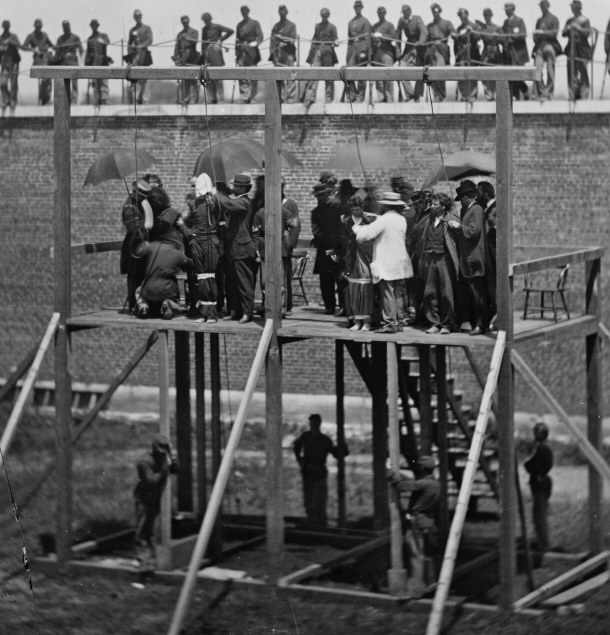
14) Anne Boleyn
The case of Anne Boleyn has been covered and discussed in
history textbooks throughout the globe. It was even portrayed fully and
graphically in a recent film starring Academy Award-winning actress Natalie
Portman. The basic story behind her execution had to deal directly with her
relationship with King Henry VIII of England.
Henry VIII and Anne Boleyn:

Anne Boleyn had allegedly been
charged with having an incestuous relationship with her brother, committing
adultery while married to the king and having a significant role in the
conspiracy plots to have the king assassinated.
Henry's Reconciliation with Anne Boleyn:

But even with multiple charges against her, Anne still was able to maintain a
level of loyalty to the king that many argue was
not warranted – especially after the way that he had treated her. However, in
1536, she was publicly executed through decapitation.
13) John Smith of England
After being convicted of robbery in 1705, John Smith
was sentenced to a death by hanging in Tyburn, England. The execution was
scheduled for Christmas Eve of that year. Instead of dying instantly, which is
what usually took place, John Smith's body dangled on the rope for over 15
minutes. This dreadful sight led to the crowds of observers screaming
"Reprieve!" in order for him to be finally cut down and taken to a home in the
nearby area that allowed him to recover. When asked to explain the overall
experience, John Smith talked about the surreal amounts of pain that he suffered
through as he went in and out of consciousness before being cut down.
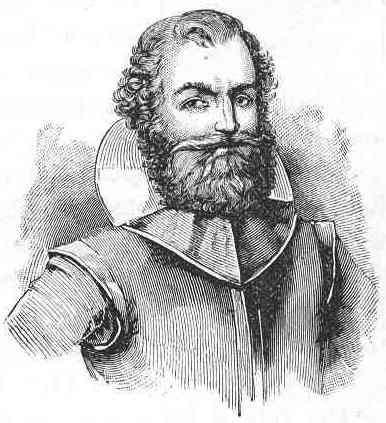
12) Wensaslao Moguel
Shortly after being captured in March of 1915 after
fighting alongside the others that were part of the Mexican revolution, Wensaslao Moguel was found guilty and sentenced to an execution by firing squad.
Even though Moguel was shot nine different times, he still managed to survive
the execution. Reports have confirmed that the final bullet was shot at a point
blank range just to make sure that Moguel had died, but even that did not work.
After managing to escape, Moguel was able to live out the rest of his life happy
and healthy. He even gained a little notoriety by having his story discussed on
the Ripley's Believe It or Not radio show in 1937.
Wensaslao Moguel Survives His Execution:
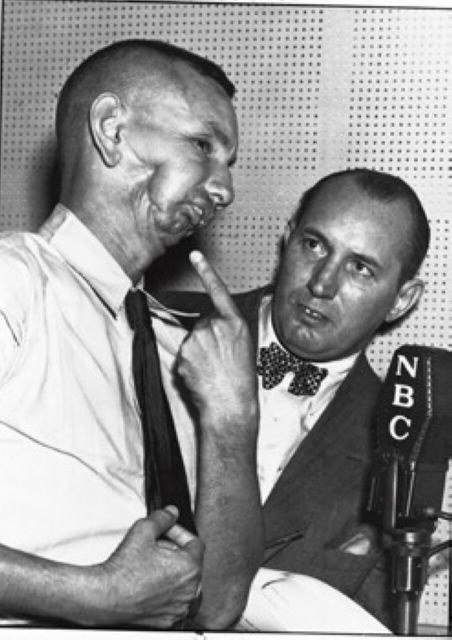
11) John Lee
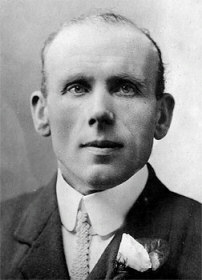 In the late 1800s, John Lee was charged in Torquay, England for
killing a woman with an axe, slashing her throat with a knife and then setting
her home on fire while she was still inside. He was sentenced to death by
hanging, which was originally scheduled to take place in February of 1885. Right
before the hanging, however, the trap door that was supposed to initiate the
hanging by dropping John Lee's body downward malfunctioned. In the late 1800s, John Lee was charged in Torquay, England for
killing a woman with an axe, slashing her throat with a knife and then setting
her home on fire while she was still inside. He was sentenced to death by
hanging, which was originally scheduled to take place in February of 1885. Right
before the hanging, however, the trap door that was supposed to initiate the
hanging by dropping John Lee's body downward malfunctioned.
The executioner tried to activate the trap door three different times, but
each attempt failed. John Lee was taken back to his cell so that they could
figure out what took place and then redo it at a later time. However, his
sentence was reduced by the Home Secretary to life imprisonment before they
could reschedule another hanging. Even though the Home Secretary recommended
that John never be released from prison, he was set free 22 years later at the
age of 41.
10) Elizabeth Proctor
 The Salem Witch Trials of 1692 were definitely filled
with controversy and overall confusion in a number of different ways. Elizabeth
Proctor and her husband were just two of the many people who were accused for
using witchcraft. Both were found guilty and sentenced to death after their
trials. However, since Elizabeth was pregnant at the time, her execution was
postponed until after the baby was born. Her husband may have figured that he
would be offered the same kindness so that he would at least get the chance of
meeting and holding his newborn child before he was put to death. Sadly, though,
he did not receive the same kindness and was executed in August of 1692.
Elizabeth remained imprisoned for the duration of her pregnancy and experienced
no major complications leading up to the very moment when she was in labor. The Salem Witch Trials of 1692 were definitely filled
with controversy and overall confusion in a number of different ways. Elizabeth
Proctor and her husband were just two of the many people who were accused for
using witchcraft. Both were found guilty and sentenced to death after their
trials. However, since Elizabeth was pregnant at the time, her execution was
postponed until after the baby was born. Her husband may have figured that he
would be offered the same kindness so that he would at least get the chance of
meeting and holding his newborn child before he was put to death. Sadly, though,
he did not receive the same kindness and was executed in August of 1692.
Elizabeth remained imprisoned for the duration of her pregnancy and experienced
no major complications leading up to the very moment when she was in labor.
She gave birth to her son in January of 1693 and began to immediately enjoy
whatever time she had left with her son. However, Elizabeth was never scheduled
for an actual execution. Later the same year, the governor released all of the
prisoners that were convicted of those charges because he felt they had all been
wrongfully convicted. Elizabeth was one of the prisoners who were released,
finally allowing her to live life as a mother while mourning the death of her
husband.
Lithograph from 1892 Depicting the Salem Witch Trials:
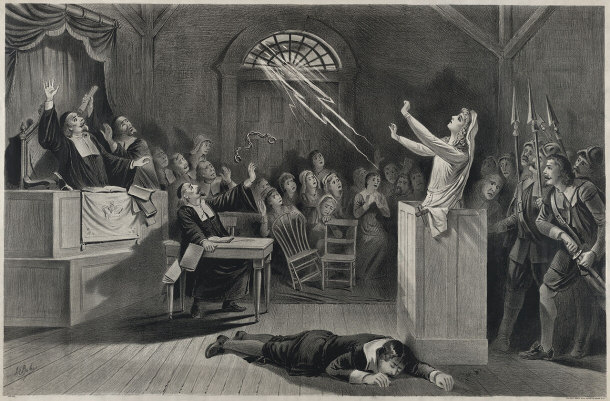
9) Julius and Ethel Rosenberg
After World War II ended, the Cold War began
shortly afterward. The tension between the United States and Russia only become
more elevated and intense with each passing year. Widespread panic began to
occur when rumors started to circulate that there were Russian spies working
directly for the Soviet Union who were living in the United States.
Julius and Ethel Rosenberg:
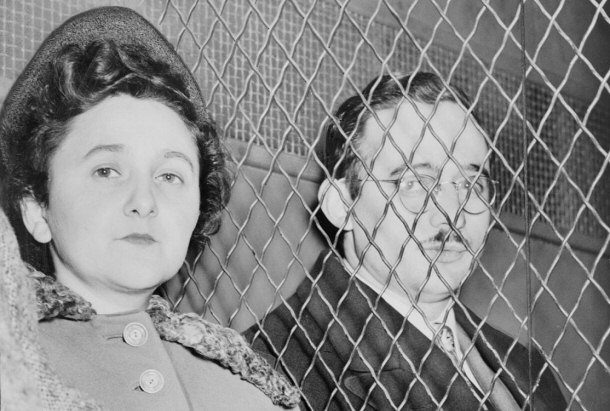
Identifying,
finding and punishing those spies soon became a priority. Husband and wife
Julius and Ethel Rosenberg were two of the highest-profile criminals charged
with selling confidential secrets to the Soviet Union about the United States'
nuclear weapons.
At the time of their execution in 1953, they had to be transferred to
Sing-Sing Correctional Facility since the Federal Bureau of Prisons had not yet
started using electric chairs for the executions of death row criminals.
View from Rockland Lake State Park of Sing-Sing:

By Nrbelex
via Wikimedia Commons
The
Atomic Cafe, a documentary film released in 1982 that explained the details
behind this execution, stated that Ethel Rosenberg's heart was still beating
after the first three standard electric shocks, so an additional two had to be
applied in order to make sure that she was completely dead.
Sketch of a Lens Mold for the Atomic Bomb Meant for Russian
Operatives:
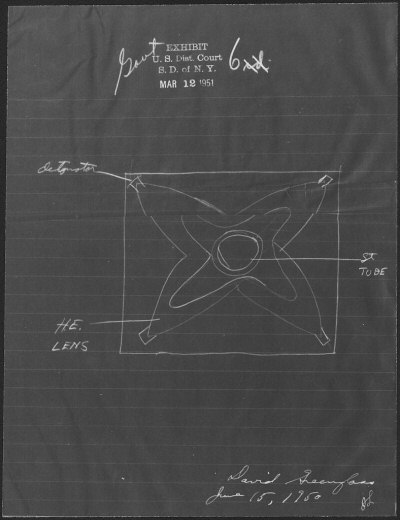
In 1995, testimonials and confessions from other people involved who decided
to come forward revealed that Julius and Ethel were key players who led the
espionage operations within the United States. Even though they became very
skilled at covering their tracks, they were eventually caught and put to death.
However, their loyalty to their cause and the overall operation prevented them
from disclosing any other names of other people who were also involved.
8) Willie Francis
Willie Francis was only 16 when he was arrested and charged
with the murder of a Louisiana drug store owner. The key piece of evidence was
that Willie had the wallet of the drugstore owner in his pocket. Willie
eventually confessed to the murder in writing after being thoroughly
interrogated by police. He even told police where to find the holster that he
used for the murder weapon before tossing it. Even after these formal
confessions, though, Willie pleaded not guilty to the actual crime. After a
trial that only lasted two days, Willie was convicted and sentenced to be
executed on May 3, 1946 by the electric chair.
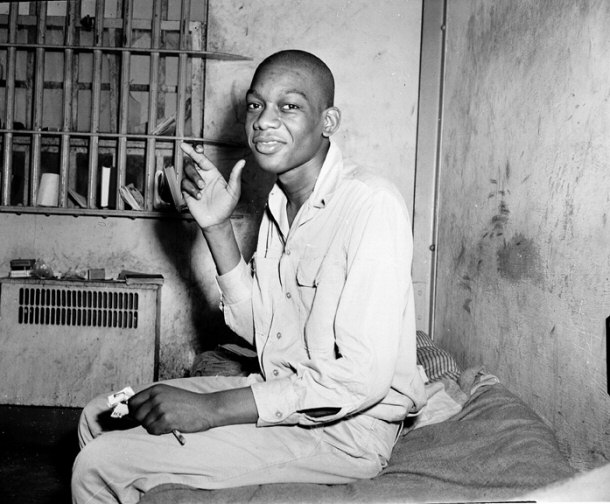
During the execution, Willie screamed for them to take it off because of
something not functioning properly. It was later discovered that the electric
chair had not been set up properly due to one of the prison guards being drunk
while working. Willie clearly saw this as an opportunity to be set free and
finally have a chance to go home and return to his normal life.
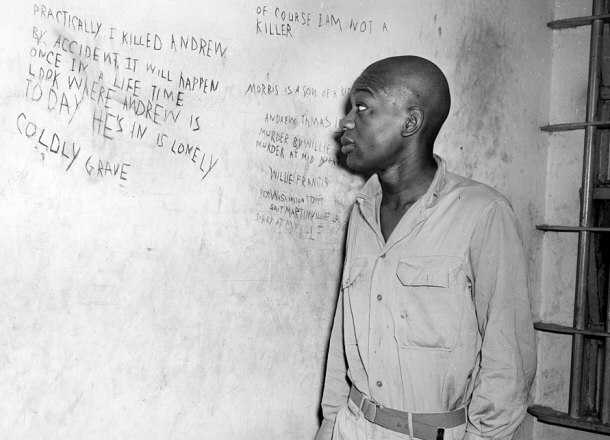
He appealed to
the Supreme Court based on the failed execution attempts and the reasons behind
it, stating that his Fifth, Eighth and 14th Amendment rights had all been
violated because of it. Even though it may have seemed as if he had a strong
case at the time, the appeal was rejected and he was executed successfully the
following year.
7) Aileen Wuorno
 Aileen Wourno's execution, and whether it was justified, is
still up for debate. Aileen's story is one of childhood abuse, domestic violence
and neglect that festered inside of this woman as she went from being a
prostitute who needed to solicit sex in order to financially support herself
into a female serial killer and alleged vigilante who would turn the people she
had sex with into murder victims shortly after she had completed her services. Aileen Wourno's execution, and whether it was justified, is
still up for debate. Aileen's story is one of childhood abuse, domestic violence
and neglect that festered inside of this woman as she went from being a
prostitute who needed to solicit sex in order to financially support herself
into a female serial killer and alleged vigilante who would turn the people she
had sex with into murder victims shortly after she had completed her services.
After she was finally arrested, Aileen openly admitted in court that she had
killed a total of seven different men that all had picked her up in Florida as a
hitchhiker between 1989 and 1990. It was after she murdered a law enforcement
agent that her murderous crime spree quickly came to a screeching halt as she
was no longer able to cover her tracks as well as she had with the previous
murders. Federal officials enlisted the assistance of Aileen's girlfriend at the
time to lure her into confessing and eventually surrendering herself to the
police.
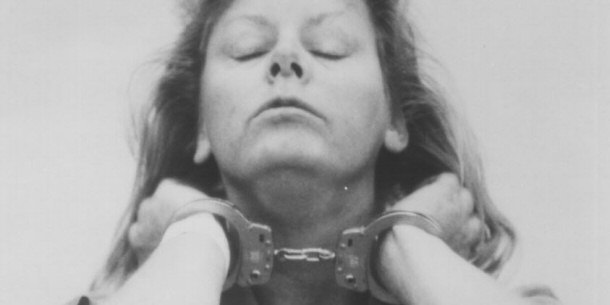
She was executed by lethal injection in October 2002, but many people say
that she was clinically insane and should have been rehabilitated and
incarcerated rather than put to death. When asked if she had any final words
before being put to death, Aileen said things like she was "sailing with the
rock," that she would be back "like Jesus," and she even referenced the "big
mother ship" from the hit Will Smith movie, "Independence Day." Actress Charlize
Theron portrayed Aileen in her Academy Award winning role in the popular 2003
movie, "Monster." The screenwriters used a 1993 documentary that covered
Aileen's life and crime spree in great detail.
6) Herman Mudgett
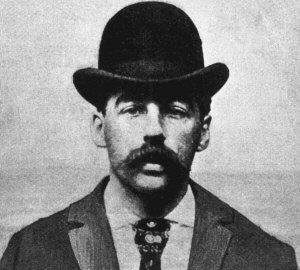 Widely known as one of the United States' first serial
killers, Herbert Mudgett, also known as Dr. Henry Howard Holmes, was executed
for his crimes by hanging after being sentenced to murder in 1896. Mudgett
opened a hotel in 1893 that was specifically designed to be used as the primary
location of his murderous crime spree. Even though he only admitted to killing
27 people, further investigations later proved that he was responsible for
taking the lives of over 200 people. Many of the victims had been taken directly
from the Chicago's World Fair the year that the hotel, which was only two miles
away from the location of the fair, had opened. Widely known as one of the United States' first serial
killers, Herbert Mudgett, also known as Dr. Henry Howard Holmes, was executed
for his crimes by hanging after being sentenced to murder in 1896. Mudgett
opened a hotel in 1893 that was specifically designed to be used as the primary
location of his murderous crime spree. Even though he only admitted to killing
27 people, further investigations later proved that he was responsible for
taking the lives of over 200 people. Many of the victims had been taken directly
from the Chicago's World Fair the year that the hotel, which was only two miles
away from the location of the fair, had opened.
His death was discussed and published in the New York Times the same year.
Herbert did not show any remorse for his murderous actions and was completely OK
with dying for them when his time of execution finally arrived. People speculate
that he may have been clinically insane as well, primarily because of his
behavior while in prison and leading up to his execution. Official reports state
that he gave advice to his own executioner, telling him to take his time so that
he did not make any mistakes. When asked if he had any final words before being
put to death, he infamously responded with, "Yes, goodbye!"
5) Gary Gilmore
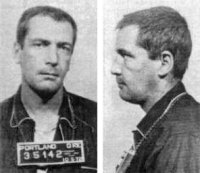 Gary Gilmore was executed by a firing a squad on Jan. 17,
1977 at approximately 8:07 a.m. at the Utah State Prison. Gary was convicted and
found guilty of murdering the manager of a local motel in Provo, Utah. Even
though he was provided with a steak dinner for his last meal, he only chose to
drink the milk and coffee that came with the food. His final words were simply
"Let's do it." Since Gary had agreed to have his organs donated after his death,
his corneas were donated to two different people within hours after he had died.
The death penalty had just been reinstated in the United States a year earlier
in 1976, so this marked the first official execution that took place after that
reinstatement. Gary Gilmore was executed by a firing a squad on Jan. 17,
1977 at approximately 8:07 a.m. at the Utah State Prison. Gary was convicted and
found guilty of murdering the manager of a local motel in Provo, Utah. Even
though he was provided with a steak dinner for his last meal, he only chose to
drink the milk and coffee that came with the food. His final words were simply
"Let's do it." Since Gary had agreed to have his organs donated after his death,
his corneas were donated to two different people within hours after he had died.
The death penalty had just been reinstated in the United States a year earlier
in 1976, so this marked the first official execution that took place after that
reinstatement.
4) Timothy McVeigh
Timothy McVeigh was the man primarily responsible for the
tragic explosions that took place directly in front of a federal building in
Oklahoma City, Okla. in 1995. This act of brutal, premeditated terrorism killed
168 people and injured close to 1,000 others. A daycare center inside the
building filled with children was destroyed in the blast, killing all inside.
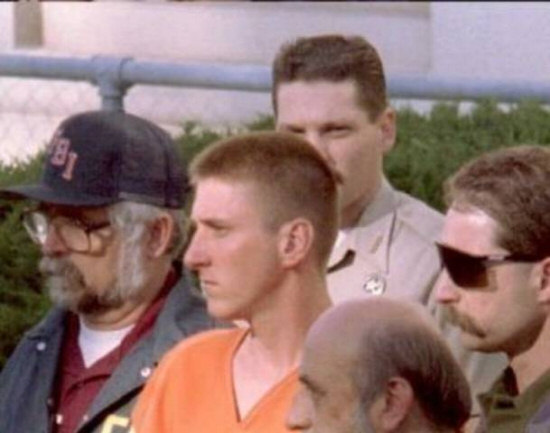
Timothy never showed any remorse for his actions. He claimed that the only
regret he had was that he was not able to level the entire building with his
explosives. For his last meal, all he asked for was a couple of pints of mint
chocolate chip ice cream. Timothy was executed by lethal injection on June 11,
2001 at approximately 7:14 a.m.

Even though he had chosen to recite a poem as
his final statement before being put to death, he decided at the last minute to
not say anything at all, according to Fox News. He was the first prisoner to be
executed by the federal government in close to 40 years.
3) Ted Bundy
Ted Bundy is infamously known for his four-year crime spree
that took place in the late 1970s, taking the lives of 30 people in seven
states. Investigators say he might have killed even more. He was already serving
time in Utah in 1975 when law enforcement agencies began to connect him to all
of the homicides that would eventually lead to his execution.
Murder Kit Found in Bundy's Car:
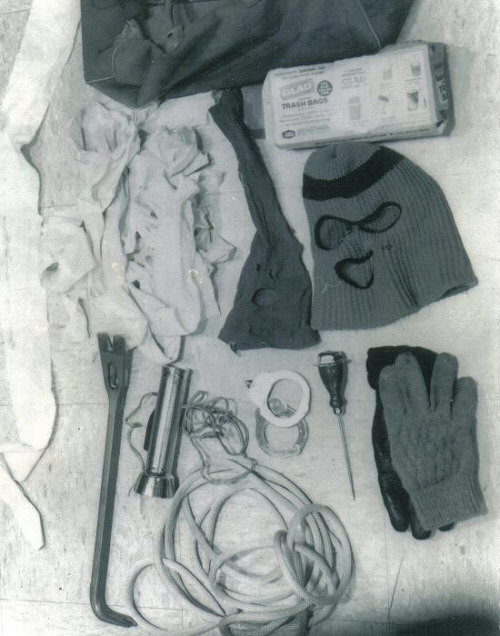
By Vidor
via Wikimedia Commons
There have been
quite a few serial killers and rapists who have committed crimes since then that
have credited Ted Bundy as one of their biggest influences and inspirations.
Bundy's FBI Photo When he was Placed on the 10 Most Wanted
List in 1978:
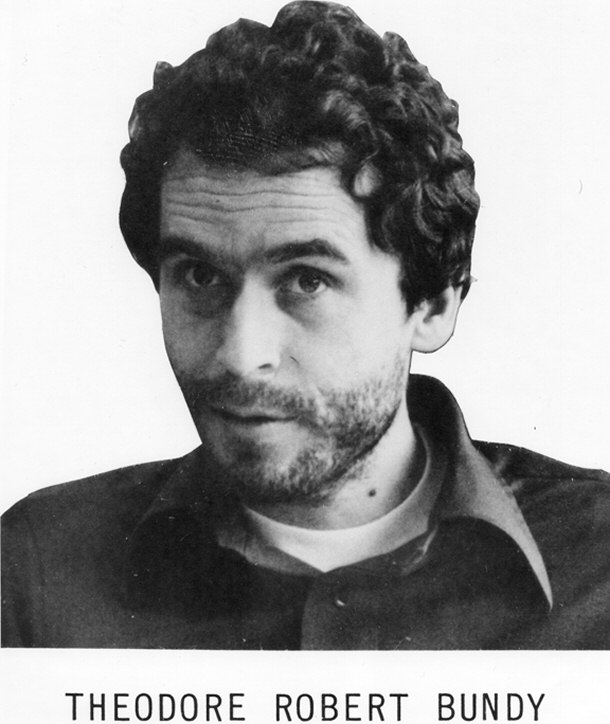
In order to escape the death penalty, he officially confessed to crimes and
murders that the officials had no idea occurred. He even lobbied to qualify for
executive clemency, advising his lawyer to get the families of the victims to
sign a petition that would postpone the date of execution. However, none of the
families signed that petition, so his execution continued as scheduled. On Jan.
24, 1989, Ted Bundy was put to death in a Florida prison by the electric chair.
Shortly after the news of his execution, his death was celebrated by thousands
as fireworks in a pasture close to the prison were ignited.
2) Brandon Wayne Hedrick
 Brandon Wayne Hedrick was convicted and charged
with the 1997 murder of a 23-year old woman, Lisa Crider. This case was one of
the biggest murder trials of the late 1990s, especially due to the age, race and
gender of the alleged criminal. After an extensive investigation and
interrogations of key suspects and witnesses, it was proved that Brandon robbed,
kidnapped and raped her before ending her life by shooting her in the face. He
was found guilty and sentenced to death in 1998. Even though he tried to apply
for a petition of clemency, it was declined by Virginia Gov. Tim Kaine. Brandon Wayne Hedrick was convicted and charged
with the 1997 murder of a 23-year old woman, Lisa Crider. This case was one of
the biggest murder trials of the late 1990s, especially due to the age, race and
gender of the alleged criminal. After an extensive investigation and
interrogations of key suspects and witnesses, it was proved that Brandon robbed,
kidnapped and raped her before ending her life by shooting her in the face. He
was found guilty and sentenced to death in 1998. Even though he tried to apply
for a petition of clemency, it was declined by Virginia Gov. Tim Kaine.
Before his execution on July 20, 2006 at approximately 9:12 p.m. in Jarratt,
Va., Brandon's final words consisted of him praying for the people that believe
"in Jesus Christ" and "the people that are unsaved that they will accept Christ"
before saying that he was then "ready to go and be free," according to the
Washington Post. This execution may go down in history as the last that was
conducted by the electric chair in the United States, especially after a ruling
was passed by the State of Nebraska in 2008 that classified electric chair
executions as being cruel and unusual punishment based on the 8th Amendment.
1) Saddam Hussein
 Saddam Hussein reigned terror on his country and
throughout the Middle East during his time as leader of Iraq. He was widely
known as the "Butcher of Baghdad" primarily because of the horrendous murdering
sprees and executions that he personally approved while in power. He allegedly
used his own military forces and chemical weaponry to fight against his own
people, primarily because of his fear of a possible uprising. Saddam Hussein reigned terror on his country and
throughout the Middle East during his time as leader of Iraq. He was widely
known as the "Butcher of Baghdad" primarily because of the horrendous murdering
sprees and executions that he personally approved while in power. He allegedly
used his own military forces and chemical weaponry to fight against his own
people, primarily because of his fear of a possible uprising.
After going to war with Iraq in 2003, Saddam famously disappeared. He wasn't
gone for long. Two of his sons and a grandson were killed during a gunfight in
July that year. Then, in December 2003, U.S. forces captured Saddam as he was
found hiding in a farmhouse hole near Tikrit.
Hussein Captured!
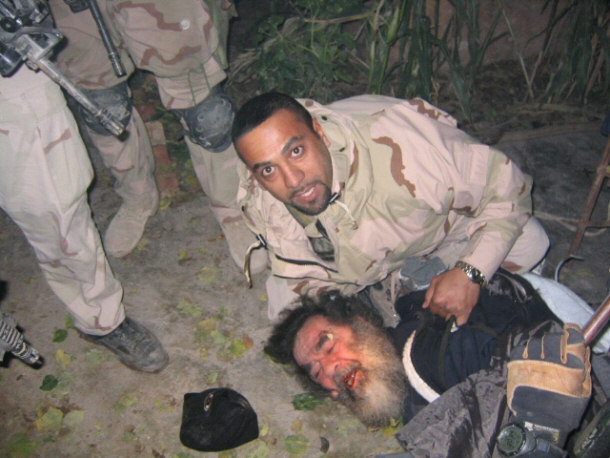
While disheveled and sporting a
full beard, reports say he was otherwise in good health. The Iraqi interim
government put Saddam through a trial, found him guilty primarily on the charge
of executing close to 150 Iraqis in 1982 and sentenced him to death for his
crimes.
Saddam Hussein Prior to his Execution:
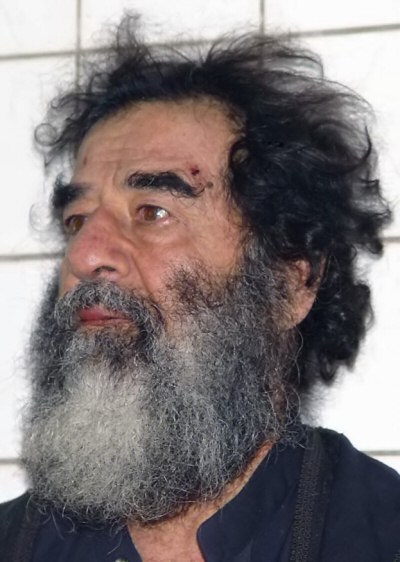
Saddam was executed on Dec. 30, 2006. Even though he formally requested to be
executed by a firing squad for dignity purposes, he was instead hung. A video
recording of the execution was uploaded to the Internet and quickly gained a lot
of viewers and global controversy. There are even reports that have been
confirmed by the lead guard of the tomb where Saddam's body was buried that he
was apparently stabled several times after he had already died.
Final Words
The Move Toward Abolishing Capital Punishment Execution, while debatable, is
a practice that has been carried out by virtually all countries for many
centuries. The earliest forms of capital punishment were often brutal, too. In
China, those found guilty could be strangled to death. Crucifixion was common
place for centuries throughout the globe, as was various forms of torture that
eventually led to death.
Although the U.S. gets a lot of flak, both internally and internationally,
for executing prisoners, it doesn't come close to the most executions by a
country. That distinction goes to China, which doesn't publish official records.
However, it's believed that up to 4,000 were executed there in 2011, according
to the Dui Hua Foundation. The U.S., by comparison, executed 43 in 2011 and
another 43 in '12. Overall, 1,329 people have been executed in the U.S. between
1976 and May 2013. And of that total, Texas leads the way, executing close to
500. That's 37 percent of all executions in the United States.
The
preferred method of capital punishment in the U.S. is lethal injection, which
accounts for almost 90 percent of all executions. But people have been executed
by electric chair, gas chamber, shooting squad and even hanging (the last of
which took place in 1996). By comparison, other country methods of
capital punishment seem much more brutal.
Gas Chamber
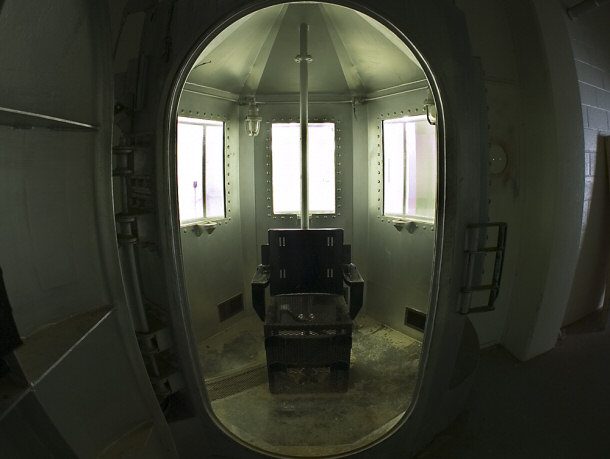
By Shelka04
via Wikimedia Commons
Hanging is allowed in more countries
than any form of capital punishment. But you could be stoned to death in several
Middle East countries if you're gay or commit adultery or other so-called
"sexual offenses." Other crimes could get you decapitated in many of those same
countries. And in Sudan, you can be sentenced to death and killed in the same
manner that the victim was killed.
Lethal Injection Room

But there has been a global move to abolish all forms of execution. According
to a 2013 report by Amnesty International, 21 countries were known to have
executed prisoners in 2012, the same number in 2011. That compares to 28
countries in 2003 and more than 50 in 1990, according to the report. And more
than 50 countries have abolished capital punishment since 1990, although India,
Pakistan and Japan recently renewed the practice. The countries with the most
executions include China, Iran, Iraq, Saudi Arabia and the U.S., with Yemen
trailing a close sixth. It's not known exactly how many people were executed
worldwide because of the China numbers. However, Amnesty International reports
that at least 682 executions were known to have been carried out across the
globe in 2012, just two more than the previous year. The number of death
sentences is down, according to the report. At least 1,722 death sentences were
handed down between 58 countries in 2012, according to the report. That compares
to 1,923 in 63 countries in 2011.
History
Top Lists:
15 Biggest Architectural Blunders
Top 15 Most Horrifying Terrorist Attacks
15 Fascinating Facts About the Vietnam War
Top 15 Amazing Ancient Egyptian Architecture
20 Little Known Facts About the Titanic
Top 10 Most Creepiest Abandoned Places in the World
26 Interesting Facts About Henry Ford
List of 15 Tough Ancient Warriors Through History
List of 15 Notorious Roman Emperors and Empresses
Top 15 Worst Pandemics in History
15 Things That Remained the Same in the Past 100 Years
Top 15 Things China Invented First
Top 15 Greatest Inventors in History
15 Interesting Facts About Abraham Lincoln
10 Inventors Who Stole Their Ideas
15 Stories of Hilarious Medieval Victories
15 Detectives Credited With Solving The Biggest Cases In History
15 Fascinating Facts About the Ancient Pyramids
15 Inventions That Were the Result of a Mistake
15 Famous Stories of Execution
16 Rare Facts About the U.S. Presidency
15 Astonishing Leadership Stories that Ended up Successfully
Informational:
Analysis of the Linear B tablets and Wall Paintings
Aristophanes and Classical Greek Comedy
The First War of Scottish Independence
|